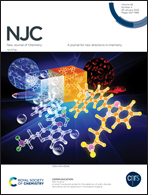Hollow microspherical Bi2MoO6/Zn–Ti layered double hydroxide heterojunction for efficient visible-light photocatalytic degradation of organic contaminants†
Abstract
In this paper, hollow Bi2MoO6 microspheres (h-Bi2MoO6) were prepared via a simple solvothermal method. Then, h-Bi2MoO6/(Zn/Ti)LDH composite photocatalysts were prepared through the in situ growth of a Zn–Ti layered double hydroxide ((Zn/Ti)LDH), owing to electrostatic interactions of opposite electrical charges. The obtained h-Bi2MoO6/(Zn/Ti)LDH composites were characterized using X-ray diffraction (XRD), Fourier transform infrared (FT-IR) spectroscopy, N2 adsorption–desorption Brunauer–Emmett–Teller (BET) analysis, scanning electron microscopy (SEM), X-ray photoelectron spectroscopy (XPS), UV-Vis diffuse reflectance spectroscopy (UV-Vis DRS), and fluorescence spectroscopy. The (Zn/Ti)LDH nanosheets enhanced the charge separation efficiency and expanded the light absorption region by constructing a heterojunction structure. As a result, h-Bi2MoO6/(Zn/Ti)LDH-2% exhibited the highest photocatalytic degradation rate which is 6.8 times that of h-Bi2MoO6. Based on the active species trapping experiment results, it can be speculated that photogenerated holes (h+) and hydroxyl radicals (˙OH) play major roles in the photocatalytic degradation of rhodamine B. What's more, the h-Bi2MoO6/(Zn/Ti)LDH composite photocatalyst exhibited excellent stability and recyclability, revealing remarkable potential for organic wastewater treatment.



 Please wait while we load your content...
Please wait while we load your content...